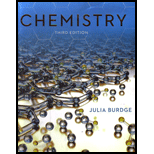
Interpretation:
The amount of KHP (in grams) required to neutralize the given NaOH solution is to be calculated.
Concept Introduction:
Acid–base titrations are useful in determining the concentration of an unknown acid or a base.
The concentration of unknown solution can be determined by titrating it with a standard solution of a known concentration.
If volumes of standard and unknown solutions are known, the concentration of unknown solution can be estimated with the help of concentration of standard solution.
The solution of a strong base like NaOH needs to be standardized as its concentration might become unstable over time. It can be standardized using KHP, which is available in a highly pure form.
So, number of moles can be calculated as
The moles of a substance are expressed as
So, the mass of a substance is given by the expression
Want to see the full answer?
Check out a sample textbook solution
Chapter 4 Solutions
Chemistry
- How many grams of potassium carbonate, K2CO3, must be dissolved to prepare 400. mL of a 0.127 M aqueous solution of the salt? answer: ______garrow_forwardQuestion:- How many grams of NaOH would you need to make 2542 mL of a 4 M NaOH solution (m.w. = 40.00 g/mol)?arrow_forwardA solution is prepared by dissolving 20.0 g of NaI in enough water to make 300.0 mL of solution. How many moles of ions are in 25.0 mL of this solution?Answer = _______arrow_forward
- What is the maximum amount of Na3PO4 that is formed from the reaction of 25.00 mL of 0.1050 M NaOH and 15.00 mL of 0.08650 M H3PO4? What is the molarity of Na3PO4? Equation is 3NaOH + H3PO4 → Na3PO4 + 3H2Oarrow_forward[Topic: Percent Concentration ] How would we prepare 250mL of a 4.4% w/v KBr solution in water? Assume that a 250mL volumetric flask is available.arrow_forwardAnswer this question correctly in the correct format that is needed. A picture of a format is below, please do this on paper with the correct steps and answer. Molarity Problem: How many moles of ammonium nitrate are in 335 mL of 0.425M NH4NO3?arrow_forward
- A sample contains one or more of the ions: aluminum, calcium, copper(II), iron(III); upon addition of NH3, after centrifuging, it looks like the picture shown below. For each metal put in the correct letter: P = definitely present, A = definitely absent, U = uncertain, can't tell if present or absent. aluminum = , calcium = , copper = , iron = .arrow_forward(need answer aasap) Hollandaise is a sauce made by combining egg yolks and butter, which have distinguishing polarity. Help Thoma find out which of the following allow substances with varying polarities combine? A emulsifier B colloid C amalgam D suspensionarrow_forwardFind % error in your experiment if theoretical molarity of HC2H3O2 is 0.975 M. Show work. 5mL of vinegar.arrow_forward
- What is the concentration of an HBr (aq) solution (in M) if 31.65 mL of it is neutralized by 48.72 mL of a 0.263 M solution of KOH (aq)? (show work)arrow_forwardRecall experiment "Empirical formula of zinc chloride": the experimental protocol requires that only distilled water be used in preparation of all solutions and cleaning the glassware. What would be the effect of using tap water instead of distilled water on the determined mass of calcium in a titrated sample?arrow_forwardWhat volume of 0.250 M sulfuric acid is needed to react with 50.0 mL of 0.100 M sodium hydroxide? (Hint: Write a balanced chemical equation first.)arrow_forward
 ChemistryChemistryISBN:9781305957404Author:Steven S. Zumdahl, Susan A. Zumdahl, Donald J. DeCostePublisher:Cengage Learning
ChemistryChemistryISBN:9781305957404Author:Steven S. Zumdahl, Susan A. Zumdahl, Donald J. DeCostePublisher:Cengage Learning ChemistryChemistryISBN:9781259911156Author:Raymond Chang Dr., Jason Overby ProfessorPublisher:McGraw-Hill Education
ChemistryChemistryISBN:9781259911156Author:Raymond Chang Dr., Jason Overby ProfessorPublisher:McGraw-Hill Education Principles of Instrumental AnalysisChemistryISBN:9781305577213Author:Douglas A. Skoog, F. James Holler, Stanley R. CrouchPublisher:Cengage Learning
Principles of Instrumental AnalysisChemistryISBN:9781305577213Author:Douglas A. Skoog, F. James Holler, Stanley R. CrouchPublisher:Cengage Learning Organic ChemistryChemistryISBN:9780078021558Author:Janice Gorzynski Smith Dr.Publisher:McGraw-Hill Education
Organic ChemistryChemistryISBN:9780078021558Author:Janice Gorzynski Smith Dr.Publisher:McGraw-Hill Education Chemistry: Principles and ReactionsChemistryISBN:9781305079373Author:William L. Masterton, Cecile N. HurleyPublisher:Cengage Learning
Chemistry: Principles and ReactionsChemistryISBN:9781305079373Author:William L. Masterton, Cecile N. HurleyPublisher:Cengage Learning Elementary Principles of Chemical Processes, Bind...ChemistryISBN:9781118431221Author:Richard M. Felder, Ronald W. Rousseau, Lisa G. BullardPublisher:WILEY
Elementary Principles of Chemical Processes, Bind...ChemistryISBN:9781118431221Author:Richard M. Felder, Ronald W. Rousseau, Lisa G. BullardPublisher:WILEY





